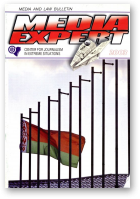Media Expert
media and law biulletin
2003
Месца выхаду: Moscov
Дата выхаду: 2003
Рэдактар: Panfilov Oleg
Выдавец: Center for Journalism in Extreme Situations
Памеры: 48 s.
Copyright © 2003 by Center for Journalism in Extreme Situations
Кнігазбор: EEDC — бібліятэка Усходнеэўрапейскага дэмакратычнага цэнтру, ul. Proletariacka 11, Białystok (папяровы асобнік)
Інвэнтарныя нумары: EEDC — [2432]
Over 17 years ago, Soviet president Mikhail Gorbachev announced perestroika and glasnost, which were perceived differently in different parts of the former Soviet Union. That was a time when new newspapers, radio stations and television companies began to emerge in the capitals and big cities of the Soviet republics. The situation changed after the collapse of the Soviet Union in 1991. The newly independent states were headed up by former Communist leaders, who were called presidents. The development of the independent press became dependent on the presidents' personal attitudes to the freedom of speech and the press. In Turkmenistan, independent newspapers and magazines existed for only a couple of months, and in Uzbekistan, the non-state press was banned a little later. In Belarus, everything changed in 1994, when Alexander Lukashenko, an unknown director of a collective farm, was elected president. Lukashenko's presidential campaign emphasized the need for corruption prevention and his program was broadly advertised by independent newspapers. At that time, they did not know that their demise would begin in just six months. (Oleg Panfilov, Editorial, fragment)
Каталёг: EEDC
Пэрыёдыка: Media Expert
